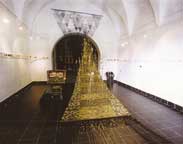“Abraxas” is a site-specific installation: the middle of the room is
occupied by an ascending triangle, populated with arrows and hard to
identify, medieval looking artifacts. On the left hand, one can see a
small table, filled with ceramic coins and an object resembling a metal
book; on the far right, there is a small blue table, placed almost out
of balance. On the walls, two strips of papyri are filled with
indecipherable symbols, and threads of wire go from the ceiling to the
floor. Triangle shaped veils hang from the ceiling. The immediate
impression is of a very fragile balance, as well as a feeling that there
is more to it than meets the eye.
Mankind has always used magical words that have to gift to alter reality.
Abraxas is such a word, thought to have special powers, both a talisman
and an incantation that can be found in numerous ancient cultures. The
Gnostic sect of the Basilideans, from the second century after Christ,
thought it named the hidden divinity and it incorporated great mysteries
because it contained the seven Greek letters which compute numerically
to 365, the number of days in the solar year. It was further believed
that Abraxas commanded 365 gods, each possessing a virtue, so there was
a virtue for each day of the year. It is the supreme Gnostic deity,
represented by the image of a man with the head of a cock and serpents
for feet, holding a shield and whip. The image can often be found on
amulets and the mystic word abracadabra is derived from it. In modern
times, Carl Jung defines it as the polymorphous world spirit, which
permeates existence itself, “the hermaphrodite of the earliest beginning”
(Carl Jung, The Gnostic Jung, Ed. Robert Segal, 1992, pp. 188), fusion
of the male and female principles.
Artwork stemming from such a fertile cultural history can only tap into
selective symbolism, otherwise the risk of becoming encyclopedic,
obscure and sterile threatens understanding. Thus, the installation
created by the two Romanian artists fundamentally focuses on one of the
ancient topics of human knowledge: the permanent duality and struggle of
the feminine and masculine principles, manifested as the duality between
material and spiritual and, at a cosmic level, in the relationship
between Sun and Moon. At different levels, it also mirrors the duality
heavenly vs. terrestrial, conscious thought vs. subconscious and light
vs. darkness (connected to the Masonic interpretation of the triangle).
The major geometric figure employed, reiterated in various sizes, is the
triangle. Alchemically speaking, the triangle stands for fire. The
symbolism of the triangle coincides with the symbolism of the number 3,
which is divinity and perfect harmony. A triangle oriented upwards
represents fire and the masculine principle; one oriented downwards
connotes the feminine principle. In Judaism, the triangle is the symbol
of God and the two triangles, Solomon’s seal, stand for the human wisdom.
One has to carefully examine the relationship between two triangles, one
being the reverse of the other: they stand for the unity of divine
nature and human nature; in Buddhism, they represent linga and yoni,
fire and water, the fundamental principles of life.
|
-
The
two main components of the installation refer to the spiritual, abstract
world, the masculine space, or animus (materialized in the two white
papyri that surround the exhibition space) and the material world, the
feminine soul, or anima (embodied by all the artifacts that populate
it). The symbols on the papyri invite the viewer to decipher this
complex alphabet, and mirror a cosmic succession of seasons and
elements, mandala’s and sometimes obscure signs that are difficult to
identify without serious alchemic and cultural reference. They represent
the eternal human quest for knowledge, for structuring the surrounding
universe, which functions according to laws unknown to humans and
sometimes hard to grasp for the unaware viewer. The structure can only
come into being by means of the organizing power of the human thought.
The two strips of paper, sharply white, are the abstractive, ideographic
symbols of the objects that build the main part of the installation, a
representation of the Sun. The spiritual world and the material world
are connected by vertical threads, symbols of the gravitational force
that connects them at all times. Its appearance as shiny theatre décor
only points at our own representation of the world, as well as to our
own prejudices and limitations in the quest for knowledge. One can see
meticulously crafted fake coins, golden books (another allusion to the
importance of culture and reading seen as deciphering the cosmic
alphabet, the one governing everyone’s existence in one form or another),
artifacts with a medieval look, and seals that circulate the reiterated
symbols of the papyri in a material form, creating the necessary link
between the two parts of the installation, the material and the
spiritual. The golden arrows serve to emphasize the idea of ascension,
as well as the phallic principle. The other two main objects, placed in
asymmetrical positions, point out to the permanently unstable balance of
our universe, which is alluded to also by the complexity of all the
parts which shape this microcosm governed by its own laws, but in the
same time communicating with the larger universe in a personal way.
“Abraxas” is a project based on a contemporary reinterpretation of
cultural history, which is rebuilt according to a different set of rules.
Based on numerology and medieval connotation, its global meaning can
only be understood if it is regarded as a whole, instead of a sum of its
parts. Even though sometimes it is tempting to focus on the craft and be
overwhelmed by the multitude of connotations, its symbolism is obviously
connected to the cultural universe as well as to the personal experience
of the two artists, who embody themselves the fundamental forces of
creation in their eternal struggle and fragile balance.
Dana Altman
|

